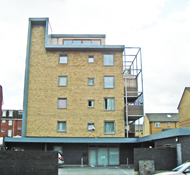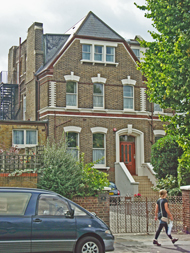Convalescent (military)
Early in 1918 the Stoke Newington Division of the British Red Cross Society was requested by the War Office to provide more help. At this stage of the war all the available hospitals were overflowing, and 2 to 3 beds were crowded together in what were once single rooms.
Rokesby, a large house with fine grounds, was acquired and converted into a Class A hospital with 43 beds.
During the summer orderlies would carry those patients well enough to be moved out to the lawn, where afternoon tea could be enjoyed in the open air. Because of the severe nature of the injuries suffered by the patients, outside trips were impossible, but concerts and other entertainments were held at the Hospital.
The Division owned an ambulence. The chassis had been lent by a Mr T.J. Wall of Southampton, and the ambulance body had been fitted by a Mr F. Adams. The Division collected patients from railway stations and transported them to various hospitals; it also worked for the City of London Military Hospital in Clifden Road.
The Honorary President of the Hospital was the Maharaja of Nepal, Sir Chandra Shum Shere Jung, who was also Head of the Gurkhas.
The Hospital closed on 31st October 1919. Of the 182 patients treated there, only one had died. He had been in the first convoy to arrive and his wounds were infected with gas gangrene.
When the Hospital closed, its furniture and equipment was given away to various organisations, including the Queen's Hospital for Children, the Metropolitan Hospital, the Home Hospital for Women, the King's Home for Nurses in Lower Clapton Road, the Refuge for the Destitute in Manor House, Dalston Lane, the Rescue Home for the Rural Deanery of Hackney and Stoke Newington at 6 Pembury Road, St Mary's Home for mothers and babies at 153 Stamford Hill, the Stamford Hill Cripples' Home, the London Hospital, the Royal Herbert Hospital, the British Red Cross Orthopaedic Clinic at 92 Dalston Lane, and the Salvation Army (which took over the ex-Hospital in 1920, moving Cotland, its home for unmarried mothers from Upper Clapton to Stamford Hill).
Present status (September 2010)
The building remained as Cotland (later renamed Crossways), a Salvation Army maternity home, until 1967. It has since been demolished and the site now contains Stroh Court, an apartment block.


The site of No. 9 and its grounds is now Stroh Court (left) and other housing (right).

No. 11 next door, a surviving period house, gives some indication of what Rokesby may have looked like.
(Author unstated) 1917 List of the various hospitals treating military cases in the United Kingdom. London, H.M.S.O.
(Author unstated) 1923 The Great War 1914-1918. Record of the Hackney and Stoke Newington Division of the British Red Cross Society. London, self-published.
(Author unstated) 1925 The British Red Cross Society. County of London Branch Annual Reports 1914-1924. London, Harrison & Sons.
www.20thcenturylondon.org.uk
Return to home page